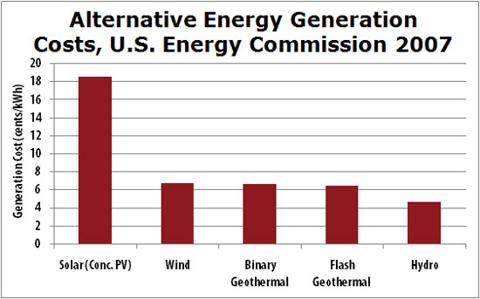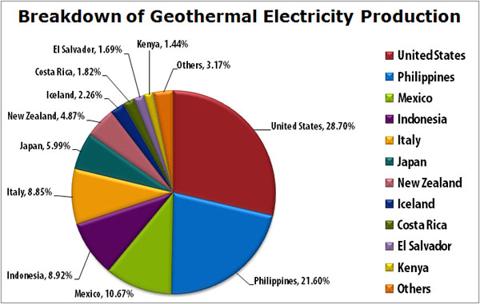
Is Geothermal the Next Hot Energy Source?
Mar 1, 2009 - Marin Katusa - seekingalpha.com
Practically every major source of power generation
in the world involves the production of heat, which
eventually becomes the electricity that we use. Nuclear,
coal, natural gas – the direct end result of all of
these processes is heat, which is usually then transferred
to water. This water is then turned into steam, which
drives the turbines that give us our electrical end
product.
It’s undeniable that making things hotter is one
of our most ancient and reliable methods of getting
things done – from cooking food to making cars run,
the energy often associated with or directly resulting
from an increase in temperature is an old and true
friend. As it turns out, so is generating power from
one of the biggest sources of heat around – around,
not out in space... yes, our own planet.
Mantle, Magma... Money!
The Earth, much like an onion, is layered – chemically,
though, rather than physically. The temperature of
the inner core has been estimated at values of nearly
7,000 degrees Celsius, or 12,000 degrees Fahrenheit.
Geothermal power is an alternative energy source,
and as such claims less than 1% of the world’s energy
supply. Understandably, while estimates of globally
exploitable geothermal reserves vary, they tend to
be fairly encouraging. Total worldwide production
of electricity in 2005 was 65 exajoules (EJ); that’s
a 65 with 18 zeroes next to it. On the other hand,
according to a 2006 report on geothermal power by
MIT, the world’s total reserves were calculated to
be over 13,000 zettajoules (ZJ) – that’s a 13 with
a whopping 24 zeroes! Of this, at least 200 ZJ were
estimated to be exploitable, with the potential for
a further 1,800 ZJ to be extracted through technological
advancements.
Other groups, such as the International Energy Agency
(IEA), have figured the numbers differently but come
to the same conclusion – there's enough geothermal
energy for thousands of years. Current geothermal
production is only 0.2 EJ, so there’s clearly plenty
of room for geothermal power to grow as an alternative
energy source.
Now that we know there’s a future for geothermal
energy generation, that brings us to the next most
important question: how economic is it? The following
chart tells an interesting tale:

Geothermal certainly holds its own with the best
of them at about 6.5 cents per kilowatt-hour. Coal
and nuclear power are still powering the way ahead
with their 4-5 cent/kWh generation costs, but geothermal
has already proven itself to be a viable alternative,
not just on the environmental front but also the economic
one.
So, how does the forecast for geothermal energy look?
With 75 new geothermal power projects over twelve
states underway in 2007 in the United States alone,
the answer is: pretty good.
It’s a Small World After All
Geothermal plants are, perhaps fortunately, nothing
special. They don’t require any particular manufacturing
concerns or exceptionally location-specific design
considerations, much like, say, a coal-fired plant.
So it's little surprise that most geothermal companies
are already as “vertically integrated” as one can
get, offering complete geothermal plant solutions
or even getting contracts to drill their own wells
and build over them, as a private utility.
That’s more or less the extent of the differences
between companies. On one hand, you have the problem
solvers, the retailers, the companies that sell and
operate geothermal systems as their primary business.
On the other hand, you’ve got the utilities, the companies
that stake geothermal deposits, get licensed, build
plants, and sell their electricity. That’s all there
is to the geothermal industry – very simple, no frills
attached.
Juniors account for a very large portion of the
geothermal pie. Geothermal juniors are all junior
utilities, companies with tenements on hydrothermal
reservoirs looking to get licensed or raise enough
money to build their first geothermal plant.
So out of these three constituents, which one should
we be betting our money on? Well, the answer should
be fairly obvious; much like with, say, uranium, our
best hope of profiting from the market lies with the
juniors, the ones looking to develop into full-fledged
utilities that sell electricity. So let’s take a look
at how the geothermal market shapes up.
Hot Potato
The United States is currently the largest producer
of geothermal energy in the world. Nonetheless, geothermal
still accounted for less than 1% of U.S. energy production
last year. Perhaps surprisingly, the Philippines come
in second place, with Mexico holding up third. Geothermal
holds a lot of potential in the United States, China,
Hungary, Mexico, Iceland, Australia and New Zealand,
but that doesn’t necessarily mean said potential is
being exploited.

More so than many of its fellow alternatives, geothermal
has kept fairly low-key in the last few years, garnering
very little interest despite being a clean and renewable
source of energy. As a matter of fact, between the
U.S. and Canadian exchanges, there are only ten geothermal
companies. Even if you include the Australian exchange,
which sees a lot of geothermal action thanks to its
abundance of HFR-type deposits, the count only gets
brought up to 23 companies.
As we’ve previously seen, most of the companies in
the geothermal sector are juniors, a statistic that
is reflected in these market cap charts. Many have
nothing more than a couple of stakes in the ground
as far as development is concerned, but that’s where
every junior starts out in this industry.
In any case, the geothermal market is certainly a
small one, but even in a small sector there are bound
to be winners. And with the increasing demand for
clean, green energy, it’s only a matter of time before
more people pick up on the fact that geothermal is
not a strange and rare form of alternative energy,
but rather a source of power just as viable as its
cousins hydro or wind – perhaps more so, because geothermal
plants tend to stay off the radar screens of nature
lovers griping about their spoiled views or ecosystems.
Low-key works both ways.
Getting Warmer
What do we anticipate for geothermal in the future?
Will there be a surge in popularity, a sudden eureka
as people and governments alike flock to geothermal
as the next savior in this current energy crisis?
Probably not. Geothermal has always been one of those
technologies with very low public awareness, and we
see nothing to indicate how that might change anytime
soon. So, barring some kind of strange series of coincidences,
a geothermal bull is not in the cards for now.
Still, does that mean that geothermal is a dead-end
market? By no means – as previously mentioned, there
were 75 geothermal projects being developed last year
in the United States alone. With less than 75 plants
currently operating in five states, that’s a significant
number. Just because there’s no public awareness doesn’t
mean it’s not happening.
In fact, it's the plain-Jane doggedness of geothermal
that we're counting on: despite lack of knowledge
about it, despite the extremely small value of the
market as a whole, geothermal still happens. And it
will keep on happening because it hits on the three
hot buttons of today's energy market: it's tested,
economically viable, and environmentally acceptable.

|